|
THE earliest centre of
religious life in our Leith district was at Restalrig, where a church or
chapel of some kind has existed from very remote times. Legend tells us
that among those who came to Scotland with St. Rule, the founder of the
first Christian church at St. Andrews, was St. Triduana, who had
consecrated herself to the service of God. To avoid the attentions of
Nectan, King of the Picts, who ruled from 706 to 732, and who greatly
admired the beauty of her eyes, the saint plucked them out and sent them
to him skewered on a thorn, after which she was allowed to live
unmolested, and spent the rest of her days in devotion and service at
Restalrig, where she is said to have died and been buried.
Her tomb, and holy well
adjacent, became the most noted places of pilgrimage in the Lothians, and
many reputed miracles were wrought by the beneficent influence of the
Blessed St. Triduana, especially on those deprived of sight or who were
afflicted with disease of the eyes. Through the offerings of the faithful
a chapel is said to have arisen over her grave, a little church, rude and
primitive in construction, after the manner of the ancient chapel now
uncovered within the foundations of the great Abbey Church of Holyrood.
We pass from the unstable
ground of legend to the sure foundations of history when we come to the De
Lestalrics and the Norman church they built at Restalrig before the days
of Alexander III. That church would consist of nave and chancel, and be
very similar to the Norman church at Duddingston built about the same time
(1143). This Norman church of the De Lestalrics became the parish church
of both Leith and Restairig, the latter place, strange as it may seem to
us to-day, being then the larger township of the two.
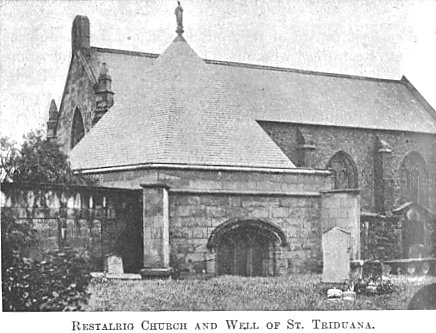
James III. and his talented
and brilliant son, James IV., were great lovers of architecture. They
rebuilt on a much larger scale the Church of Restalrig, which they did
their best to enrich and endow. One of these endowments was an annual
grant of £28, payable from the rents of the King’s Wark on the Shore.
During the same period a chapel was built, or more probably rebuilt,
enclosing the well below it under beautiful Gothic stonework, which still
remains. The chapel, which formed the upper story, was destroyed at the
Reformation, and the well filled up as a monument of idolatry. This well
of St. Triduana and that of St. Margaret, which once stood within a few
hundred yards of it in the Clockmill Lane, are the two most
architecturally beautiful wells in Scotland. St. Margaret’s has been
removed to the King’s Park, though it has left its name behind it to the
North British Railway works which displaced it.
The well of St. Triduana has been cleaned
out and restored. The chapel that once stood above it, enclosing her
shrine, has not as yet been rebuilt, but an effigy in stone of the once
far-famed St. Triduana,
"Quhilk on ane thorn
has baith her ene,"
surmounts the apex of the well, just as her
image in the days of the old faith stood above the altar in her chapel.
A stirring and busy place must Restalrig
have been in pre-Reformation times, when so many simple and devout souls,
rich as well as poor, came to seek healing for their bodies and salvation
for their souls at the well and shrine of St. Triduana, and went away
consoled and full of hope that by the powerful intercession of the blessed
saint their desires would be fulfilled. To this mediaeval parish church at
Restairig, too, went the people of Leith on Sundays, and especially on
holy days, which they dearly loved because of the freedom they brought
from the dull and monotonous routine of their daily toil. But the
inconvenient distance which separated the Leithers and their parish church
at Restalrig, in those days when the church was more closely associated
with the everyday life of the people than it is now, made them resolve to
have a church nearer home, within Leith itself.
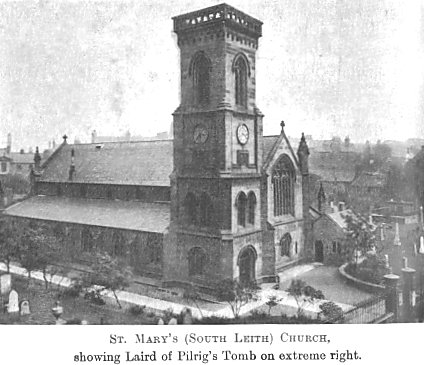
This church, familiar to us
all to-day as South Leith Church, was, like the one at Restalrig,
dedicated to the Virgin Mary, who thus became the patron saint of the
community, and took the chief place in the town arms. That is why in older
days it was often called St. Mary’s and oftener still, "Our Lady
Kirk" of Leith, as if it had a very warm place in their hearts. And,
indeed, it might well have, for it gave them their great annual holiday. A
great time of rejoicing in all Catholic countries to-day, as in days gone
by, is the 15th of August, when all make holiday because
The blessed Virgin
Marie’s feast,
Hath then his place and time,"
for on that day, according
to Catholic belief, the Holy Virgin was miraculously taken up into heaven,
as depicted in Rubens’s great picture at Antwerp.
But our old Catholic
forbears in pre-Reformation Leith had a double cause for rejoicing on that
day. The 15th of August was not only the Festival of the Virgin, but also
the feast day of their patron saint. Are not the town arms to-day a quaint
old-world galley, in which the Virgin sits enthroned under a canopy with
the Holy Child? As in Edinburgh on St. Giles’ Day, all the trade guilds
in the town, headed by the priests of St. Mary’s, went in procession,
bearing the image of the Virgin decked in jewels and costly raiment before
them. All the members of the family who worked elsewhere endeavoured to
pass the day among their own people, with whom they spent a joyful evening
over pancakes and other dainties, telling "geists," or stories,
round the family hearth.
Strange as it may seem, we
have no record as to who were the founders of St. Mary’s Church, nor
do we know exactly the date of its erection; but neither is difficult to
guess. We have seen how the good folk of Leith, shut out from being
merchants, became mariners and shipowners, like Sir Andrew Wood and the
Bartons, bringing much wealth to the town. Under the peaceful and ordered
government of James IV., and the encouragement he gave to Leith sailormen
and shipping, the town advanced rapidly in wealth, and was more prosperous
during his reign than at any succeeding period
until after the Union of 1707. James IV., like
his father, was also a great lover of building, and the growing wealth of
the town made their reigns a noted building epoch in our neighbourhood. In
James III’s time the masons and wrights of Edinburgh had become so
important that they had been incorporated as a guild by the Town Council,
and had had assigned to them the aisle and altar of St. John the
Evangelist, now the Montrose Aisle, in St. Giles’ Church. Cochrane, the
king’s Master Mason, a man of outstanding ability as an architect, had
been hanged at Lauder Bridge; but he was succeeded in his post by John
Milne, the first of a talented family of royal masons, whom we shall see
doing much building work in Leith that still survives in our midst.
We have the wealth and
prosperity of Leith at this period reflected in the building of the
Collegiate Church of Restalrig, the erection of the bridge and chapel of
St. Ninian, and now in the founding of the great Church of St. Mary in the
Kirkgate, and all within a few years of one another. St. Mary’s was
erected before 1490, and is therefore in the ornate style of architecture
known as Decorated Gothic, which was in fashion in Scotland during the
fourteenth and fifteenth centuries. Beautiful traceried windows are the
most noticeable characteristic of the Decorated style. The two finest in
South Leith Church to-day are the east and west windows, but they are
modern. The stonework of their predecessors was removed by the restorers
of 1847. That the west window had looked down on many an historic scene,
enacted both within and without the old church, mattered nothing to them.
It now forms a much-prized decorative feature of a church by the shores of
Loch Awe. Nothing could better show with what heedless and irreverent
spirit those who restored South Leith in 1847 went about their work.
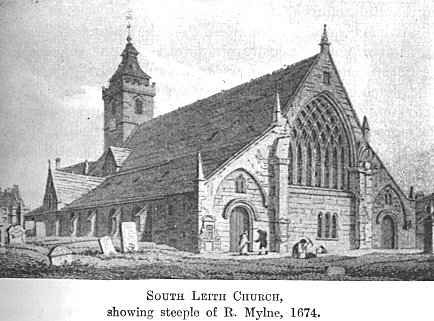
South Leith Church has also
suffered much in past centuries from the rude hand of war. What survives
to-day is only a fragment of a noble cruciform church, once as large,
though not so broad, as St. Giles’ is today. Only the nave of this great
church remains to us now. The choir and transepts, with the central tower,
were ruined by the guns of the English in 1560. Two of the four great
pillars that once supported the tower may be seen from within the church,
forming part of the east wall of the nave. Before the restoration in 1847
these were also visible from the outside, as old prints show.
In pre-Reformation times
the upkeep and reparation of the church fabric was divided between the
clergy and the people, the clergy maintaining the choir where they alone
worshipped, while the people upheld the nave. In the simple ritual of our
Presbyterian form of worship the choir was not needed, and was generally
allowed to fall into ruin. The choir and transepts of South Leith Church,
therefore, after being ruined by the cannon of the English during the
siege of 1560, when a cannon-ball passed right through the building from
east to west during the celebration of Mass, were never rebuilt. Still,
what remains forms a beautiful and stately church.
It has been often remarked
that the pillars of the nave are not directly opposite one another. But
this feature is not peculiar to St. Mary’s, for similar irregularity in
the placing of the pillars may be noticed in St. Giles’. This may have
arisen from careless measurement, but is more probably due to some
difficulty of site. Parts of the foundations of choir and transepts still
exist beneath the soil of the churchyard.
The ruins, as at Restairig,
became a convenient and ready quarry from which to obtain building
material. Carved and moulded stones, and even portions of sculptured
memorial tablets, have been found in demolishing the walls of old houses
in and about the neighbourhood of the Kirkgate, for our pre-Reformation
forefathers, like the later church restorers, were in no way distinguished
for their veneration for things sacred.
The earliest notice we have
of St. Mary’s Church is in 1490, when Peter Falconer gifted the annual
rent of a house in "the Lees," the district in and around
Yard-heads School and Henderson Gardens, for the maintenance of the
chaplain of St. Peter’s Altar in the new Church of the Blessed Virgin
Mary in Leith. A few years later, in 1499, Gilbert Edmonston similarly
endowed the Altar of St. Barbara. Peter Falconer and Gilbert Edmonston
were two of the best known of Leith’s sea captains at this period. Peter
Falconer was a man of wealth, as many of Leith’s shipmasters at that
time were. He had sailed much in northern seas. For that reason, when the
uncle of the King of Denmark came to visit the Scottish Court, James IV.
lodged him in the house of Peter Falconer in Leith. St. Peter’s and St.
Barbara’s were only two of many altars in this once large and beautiful
church.
The high altar in honour of
the Virgin Mary stood at the east end of the choir, with a beautiful
statue of Our Lady standing above it. In front hung an oil lamp, always
alight night and day, in honour of the sacramental bread or host, which,
enclosed in its jewelled pyx, was suspended just over the altar. The
upkeep of this lamp was in all likelihood provided for by the rent of the
Lamp Acre at Seafield. This piece of ground lay adjacent to lands
belonging to the Lamb family, who had been dwellers in Leith from the days
of Bruce, and may have been gifted by one of them for the welfare of the
souls of his parents and of his own.
The church door giving
access to the high altar was never closed, so that the faithful might come
to worship there at any hour of day or night. Opposite this Gothic
doorway, in the churchyard wall, was a wicket, perhaps originally simply a
stile, as it was named The Mid-style, leading out to Coatfield and
Charlotte Lanes, which, before Lord Balmerino extended his garden to the
Links, formed one continuous street with Quality Street, and was known as
the Road to the Altar-stane.
The aisles still remain in
South Leith Church, but the chantry chapels, with their altars between the
pillars, are gone. A chantry chapel was simply a part of a church screened
off, before whose altar Masses were sung for the good estate of the
founder who endowed it and other persons named by him, and for the good of
their souls after death. Such endowed services were known as chantries,
and were intended to continue until "the day of doom."
Now, after reading about
those various chantry chapels and their pious donors, we need not lament
that the founders of this once great and still beautiful Lady Kirk of
Leith are unknown to us. They are well known to all of us, not as
individuals, save a few exceptions, but in the mass, for they were the
people of Leith themselves, chiefly through their trade guilds, which,
like that of the cordwainers or shoemakers, had each its altar and chapel
in the church. As we have learned before, the promoting and maintaining of
religious services at the altars of their patron saints would seem to have
been one of the chief purposes of these old guilds.
Sir John Logan, in
accordance with the family tradition of loyalty and devotion to the
Church, must have given the site and the churchyard, and his uncle of the
Sheriff Brae and his cousins of Coatfield would lend a helping hand. The
parson of the Church of Restalrig, without whose sanction no daughter
church could have been founded in the parish, gave his blessing and his
prayers. Indeed all, rich and poor alike, shared enthusiastically in the
work, for it was to bring the benefits of religion to their very doors.
The sound of its bell, as it rang out for the various daily services,
would be for them, as some one has said, a sweet and holy melody, for it
would enable those within reach of its sound to join in spirit in the act
of worship being offered in God’s house.

As most of the inhabitants
of the town belonged to one or other of the various guilds, the members of
each, by means of their guild chapels, came to have their own part of the
nave for worship and for burial. These various chapels, with all their
rich adornment, were swept away at the Reformation, but we have neither
record nor tradition of the change. Then, too, it was decreed that the
people of Restalrig were to repair to the Church of South Leith, which in
1609, by an Act of the Scots Parliament, became the place of worship for
the parish. It was further decreed that the Church of Restalrig as "a
monument of idolatry be utterly casten doun," and soon little more
than the choir of this once famous church was left standing. The
shrine of St. Triduana was destroyed at the same time, and her holy well,
to which devotees thronged in pilgrimage "to mend thare ene,"
was filled up. Yet even to this day people sometimes wander to Restalrig,
who still have faith in the healing virtues of the Holy Well of St.
Triduana.
At the Reformation the Rev.
David Lindsay, the friend of Knox, and one of the most noted of the
Reformers, became the first Protestant minister of St. Mary’s. He was
designated parson of Restalrig and minister of South Leith. The chapels
and altars of the old craft guilds went from the church with the old
Catholic faith. Under the name of trade incorporations, however, these
guilds were still closely associated with the work of the church. It was
they who paid the stipend of the second minister in the days when the
church had two. They were largely responsible for its upkeep and
maintenance, for to them and the other parishioners the church had been
bequeathed by the Golden Charter of James VI. in 1614, together with the
churchyard, the lands of the Hospital of St. Anthony, the Chapel of St.
James at Newhaven, and such other properties as the Lamp Acre at Seafield
and the Holy Blood Acre at Annfield. But the lands of Parsonsgreen, which
once formed the greater part of the glebe of the parson of Restalrig, as
the name would lead us to suppose, now became the patrimony of the Logans
of Parson’s Knowes, as these lands were called in the old
pre-Reformation times.
After the disastrous
overthrow of the Scots at the Battle of Dunbar Leith was occupied by
Cromwell’s troops, when the church was forcibly taken from the
parishioners and, with the churchyard, was turned into a depot for
military stores. Pews were just then coming into fashion, and those that
had up to this time been placed in the church were used by the Ironsides
for firewood. The people of South Leith had now to go to Restalrig for
worship, just as their fathers had done before them; and save for a few
months in 1655, when they were again allowed to use the church, they held
their services around the ruins of the ancient village church at Restalrig
until 1657, a period of seven years. At that date the English garrison and
their military stores were removed to the newly built Citadel, when South
Leith Church was once more opened for worship to the great joy of the
parishioners.
From just before the days
of Cromwell, as we have already seen, pews began to be placed in the
church, and this was done in a way that is highly interesting and
instructive. Each trade incorporation had its pews placed just where the
guild altar had been situated in olden days, and round which its members
had worshipped. Their galleries and pews were adorned with the heraldic
emblems of the craft. Some of these have been restored in recent years,
and show us how the sittings in the church were apportioned among the
various incorporations. The gallery or loft of the Trinity House was at
the east end of the church, while that of the maltmen was at the west end
and now forms the choir and organ loft. On the floor beneath this gallery
some tombs of the maltmen’s incorporation have escaped the destroying
hand of the so-called church restorer. The north side of the nave was
occupied chiefly by the hammermen, shoemakers, and porters, while the
south side was given up to the merchants and traffickers. The trade
incorporations still continued to bury their dead where their chantry
chapels had stood in the old Catholic days. It is plain, however, that
they could not go on doing so in the limited space within the church. So
in the middle of the seventeenth century this custom was departed from,
save in the case of a few distinguished persons. It now became general for
all to be buried in the churchyard, which was divided off in a way that
forms an instructive example of how much the customs of past days still
influence the present. Each trade guild had, as a burial-place, that part
of the churchyard allotted to it adjacent to its sittings within the
church, where in ancient days the guild altar had stood and before which
its members had been buried.
Beyond the churchyard wall
runs one of the main thoroughfares, which had been named Constitution
Street from the zealous opposition of the townsfolk to Roman Catholic
Emancipation, against which all the churches and trade incorporations of
Leith had petitioned again and again. And yet, all the time, the location
of their sittings within the church, and of their burial-places in the
churchyard without, had been determined by the religious customs of their
old Catholic forefathers. Truly we Leithers are a contradictory people.
The parish churches and
churchyards of Leith and Restalrig are so full of interest that they would
require a book to themselves. Within the limited space of a single chapter
one cannot do more than briefly notice a few of the more outstanding
features of interest associated with them. The ringing of the church bell
each night and morning is another instance of a custom being continued
long after it has outlived the purpose for which it was instituted. It
shows us that in earlier days the Church regulated the hours of labour as
well as the morals of the people—days when clocks and watches were so
expensive that only the rich could purchase them. But in pre-Reformation
days this bell was more than a mere factory bell: it was the Angelus, that
summoned its hearers to matins and vespers that they might begin and end
each day’s labour with an act of worship. Let us hope that this bell
will long continue to ring, for, though it may have little meaning and
purpose now, still it is one more link between our time and the pious days
of yore. For long after the Reformation North Leith rang its bell at 10
p.m., while South Leith sent round the town drum at the same hour to warn
all people within doors. "Elders’ hours" had to be observed in
old-time Leith.
The great iron guards
erected to protect the graves against the nefarious violations of the
Resurrectionists form a striking feature along the north wall of South
Leith Churchyard, and are very noticeable in Restalrig. They all date from
before 1832, in which year the Anatomy Act, by allowing medical schools to
acquire subjects for dissection in a legal way, put an end to the trade of
the Resurrectionists.
In both churchyards may be
seen excellent specimens of tombstones, especially those of cordwainers
and hammermen, adorned with the heraldic emblems of the trade of those
whom they commemorate, and showing the pride of the old craftsmen in being
members of the incorporation of their craft. A much weather-worn tomb of a
hammerman in Restalrig not only shows the heraldic emblems of the craft,
"the hammer aneath the croon," but also the trade motto,
"By hammer and hand all arts do stand." Near the centre of the
churchyard is one showing the cordwainer’s emblems, "the cutting
knife aneath the croon," while over the top is the following couplet
"The life of man’s a tolling
stone,
Moved to and ho, and quicklie gone."
Among the noted tombs in Restalrig
Churchyard are those of General Rickson, the companion of General Wolfe,
the hero of Quebec; Lord Brougham’s father; Louis Cauvin; Lang Sandy
Wood, the famous surgeon of Sir Walter Scott’s time; and that eccentric
creature, Henry Prentice, who set up his own tombstone in the Canongate
Churchyard,
and inscribed upon it part of his epitaph, which his friends, if he had
any, never completed. The boys of the Canongate making it a target for
stones, as its chipped surface still shows, he had it removed to Restalrig,
and was eventually buried beneath it.
St. Mary’s Churchyard is the Greyfriars’ of
Leith. Crowded within its narrow limits lie generation after generation
of its inhabitants. Round its walls are the stately monuments of her
merchant princes. In the portion of the churchyard set apart in days of
old for the "Gentlemen Traffickers" lies one whose name the
genius of Robert Louis Stevenson has made familiar wherever the English
language is spoken, the Laird of Pilrig to whom be brings his hero,
David Balfour, in the opening chapters of Catriona’. Opposites
on the walls of the church, is the memorial stone of John Home, the
author of Douglas. To the east of these is a fine monumental
stone to the memory of Robert Gilfillan, who wrote the beautiful song,
"O, why left I my hame?"—a song which has touched the
hearts of so many Scots exiles, and among them that of the gifted author
of Catriona".
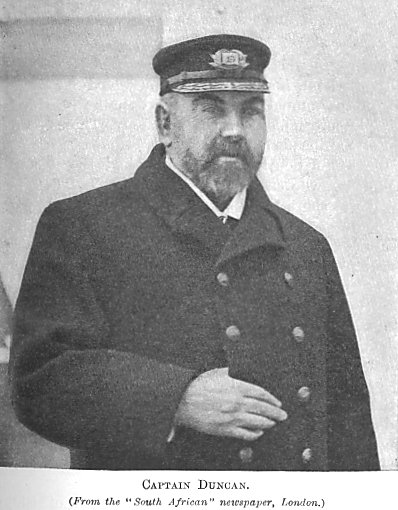
And last, in the portion of ground at the east end
of the church allotted to the mariners, is the handsome tomb of that fine
old Leith salt, as was his father before him, Captain Robert Duncan, who was born in
Water Street, and who rose to be Commodore of the Union-Castle Line of
Mail Steamers. Always a favourite with passengers, and, like Tom Bowling,
"the darling of his crew,"
"He never from his word
departed,
His heart was kind and soft,
Faithful below he did his duty,
And now he’s gone aloft."
He was a generous friend to
the boys and girls of Leith. many of whom, now grown-ups, must have happy
memories of the annual picnic to Aberdour he provided for their pleasure
under the charge of Mr. Thomas Fraser, then of Yardheads School.
In 1847—8 South Leith
Church had the misfortune to undergo what is called
"restoration." That means that it was shorn of all its ancient
features, and made to look as new and up-to-date as possible. The old
porch was removed, but its position is marked, by a label or stone
moulding on the north side of the church tower, while a similar moulding
on the gable facing the Kirkgate marks the site of the old west door,
which, however, was not used. The walls had been covered with memorial
tablets to those who lay beneath just as in the days before the
Reformation. These were all removed, and the tombstones in the floor, many
of them of beautiful workmanship, were used to pave the vestibules and
stair landings leading to the galleries, where they may still be seen
divided and mutilated to fit them in position. The oldest, bearing the
date 1593, is to one of the Logans, probably of Coatfield.
The Kirkgate gateway marks
the site of the old entrance porch, which contained several chambers and
was called by its old pre-Reformation name of the Cantore or Song School,
where the boys were trained to sing in the church choir. Attached to the
walls of the Cantore were the "jougs" which now hang in the
church porch within the tower. As in St. Giles’, the outside stonework
is new, but much of the interior is old, and has been consecrated by the
prayers of the many generations of Leithers who worshipped here ere
"They wan their rest,
The. lownest and the best,
I’ the auld kirkyaird when a’ was dune."
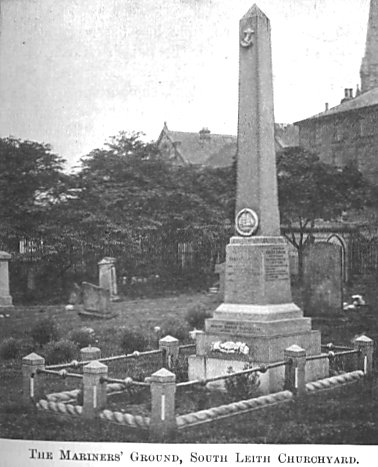
|

